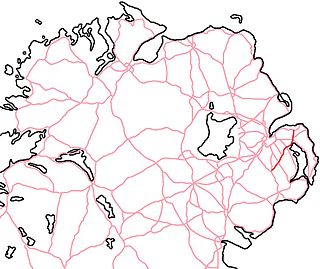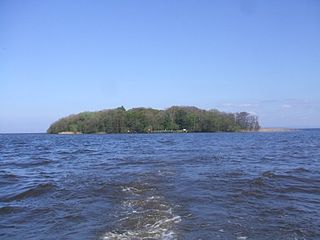
Cranfield Point is the southernmost point of Northern Ireland. It is located at the mouth of Carlingford Lough in the townland of Cranfield, County Down.

The River Bann is the longest river in Northern Ireland, its length, Upper and Lower Bann combined, being 129 km (80 mi). However, the total length of the River Bann, including its path through the 30 km (19 mi) long Lough Neagh is 159 km (99 mi). Another length of the River Bann given is 90 mi. The river winds its way from the southeast corner of Northern Ireland to the northwest coast, pausing in the middle to widen into the enormous Lough Neagh. The River Bann catchment has an area of 5,775 km2. The River Bann has a mean discharge rate of 92 m3/s. According to C. Michael Hogan, the Bann River Valley is a settlement area for some of the first human arrivals in Ireland after the most recent glacial retreat. The river has played an important part in the industrialisation of the north of Ireland, especially in the linen industry. Today salmon and eel fisheries are the most important economic features of the river. The river is often used as a dividing line between the eastern and western areas of Northern Ireland, often labelled the "Bann divide". Towns, councils and businesses "west of the Bann" are often seen as having less investment and government spending than those to the east. It is also seen as a religious, economic and political divide, with Catholics and Irish nationalists being in the majority to the west, and Ulster Protestants and unionists in the majority to the east; and with the financial and industrial capital of Greater Belfast to the east with the west of the Bann being more agricultural and rural.

The Ards Peninsula is a peninsula in County Down, Northern Ireland, that separates Strangford Lough from the North Channel of the Irish Sea on the north-east coast of Ireland. Several towns and villages are located on it, including Donaghadee, Newtownards and Portaferry. Newtownards is considered to be the largest conurbation, as the larger town of Bangor, which is also geographically located on the north end of the peninsula, is excluded from the Ards district. The peninsula has a mild marine microclimate, with dry and fertile soils suitable for extensive agriculture. The Ards Peninsula contains, near Portavogie, the most easterly point on the island of Ireland.
Lough Egish is a rural area in County Monaghan, Ireland, which takes its name from the local lake, Lough Egish. It is situated approximately midway between Ballybay, Castleblayney and Carrickmacross.

Saul is the name of a townland and civil parish in County Down, Northern Ireland.
The Crom Estate is a nature reserve located in the south of County Fermanagh, Northern Ireland, along the shores of Upper Lough Erne. It is one of three estates owned and managed by the National Trust in County Fermanagh, the others being Florence Court and Castle Coole mansions. The estate comprises 1,350 acres (5.5 km2), composed primarily of riparian forest. Some trees are so ancient that physical access is restricted.

Killinchy is a townland and small village in County Down, Northern Ireland. It is two miles inland from the western shores of Strangford Lough in the Borough of Ards and North Down. It is situated in the townland of the same name, the civil parish of Killinchy and the historic barony of Dufferin. It had a population of 539 people in the 2011 Census.
Springfield is a small settlement in County Fermanagh, Northern Ireland, near Enniskillen and Lough Erne. In the 2001 Census it had a population of 69 people. It is situated in the Fermanagh and Omagh District Council area.
The Washing Bay is a small bay on the south-west corner of Lough Neagh, in County Tyrone, Northern Ireland. It is in the civil parish of Clonoe, the barony of Dungannon Middle, and Dungannon Borough Council.
Gawley's Gate is a small village in County Antrim, Northern Ireland. It is situated on the south-eastern shore of Lough Neagh, seven miles to the north of Lurgan and ten miles west of Lisburn. It is notable mainly for Gawley's Gate Inn which attracts patrons from the outlying townlands. It also has a jetty and picnic area which is popular amongst many boating enthusiasts on the Lough. It consists of merely half a dozen houses in close proximity; however, it is a focal point for much of the countryside on the shore of Lough Neagh from Glenavy to Lurgan. The rural location means that much of the community is involved in farming in some capacity. The landscape is quite wet with marshland and dense woods giving way to cleared hillocks or 'islands' where settlements have developed. It also a popular destination with wildfowlers and birdwatchers due to the habitat which exists particularly around the RSPB sanctuary at nearby Portmore Lough.

Portmore Lough is a small lake in southwest County Antrim, Northern Ireland that drains water into nearby Lough Neagh. It is roughly circular and covers an area of 286 hectares. The Lough and its shoreland is designated a Ramsar site, a Special Protection Area (SPA) and an Area of Special Scientific Interest (ASSI). The lough is now part of a Royal Society for the Protection of Birds nature reserve.
Derrymore is a small village and townland in County Antrim, Northern Ireland. In the 2001 Census it had a population of 243 people. It lies on the shores of Lough Neagh, within the Craigavon Borough Council area.

The A21 is a road in County Down in Northern Ireland. The route commences in Bangor, passing through Newtownards, Comber, and Ballygowan, and finishes on the northern outskirts of Ballynahinch.

The A22 is a road in County Down, in Northern Ireland. Its route starts in Dundonald and runs to Comber, forming the main transport corridor connecting Belfast and Comber, a commuter town situated 8 miles outside of the city. After bypassing Comber town itself, the route continues along the eastern shores of, though not directly adjacent to, Strangford Lough. The route passes through Lisbane, Balloo, and Killyleagh, terminating in Downpatrick.

Coney Island is an island in Lough Neagh, Northern Ireland. It is situated approximately 1 km from Maghery in County Armagh, is thickly wooded and of nearly 9 acres (36,000 m2) in area. It lies between the mouths of the River Blackwater and the River Bann in the south-west corner of Lough Neagh. Boat trips to the island are available at weekends from Maghery Country Park or Kinnego Marina. The island is owned by the National Trust and managed on their behalf by Craigavon Borough Council. Coney Island Flat is a rocky outcrop adjacent to the island. Although Samuel Lewis called Coney Island the only island in County Armagh, Armagh's section of Lough Neagh also includes Croaghan Island, as well as the marginal cases of Padian, Rathlin Island and Derrywarragh Island.

Crom Castle is situated on the shores of the Upper Lough Erne in County Fermanagh, Northern Ireland, and set within a 1,900-acre (7.7 km2) estate.

The Cliffs of Magho are a 9-kilometre-long (5.6 mi) limestone escarpment located in the townland of Magho, County Fermanagh, Northern Ireland. The NNW-facing cliffs overlook the western reaches of Lower Lough Erne and define the northern edge of Lough Navar Forest, a major plantation managed by the Forest Service of Northern Ireland. A popular viewpoint atop the cliffs is accessed by a forest drive.

Boneybefore is an area of Carrickfergus in County Antrim, Northern Ireland. It lies between the A2 road and Belfast Lough.

Ards and North Down is a local government district in Northern Ireland. It was created on 1 April 2015 by merging the Borough of Ards and the Borough of North Down. The local authority is Ards and North Down Borough Council.
Swan Island is an island measuring 0.1 ha within the Larne Lough Area of Special Scientific Interest (ASSI) near Larne, Northern Ireland. The island is formed by stabilising shingle, gravel and stones overlain by a thin layer of soil. It is sited 550 m from the west shore of the lough and 3.1 km from the mouth. The ASSI is also an SPA because it regularly supports internationally important numbers of light-bellied brent geese in winter.
















